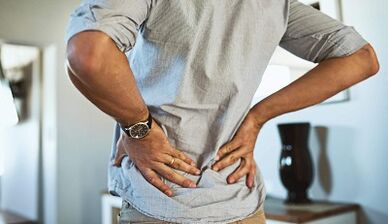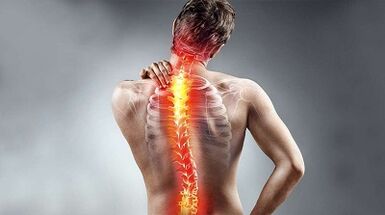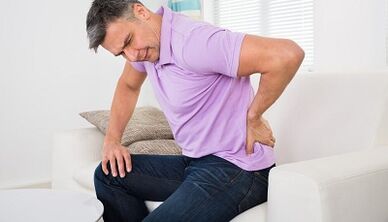
Back pain can occur at any age, but more often between 35 and 55 years old.Spinal pain is associated with how the bones, muscles, intervertebral discs, ligaments, tendons and nerves work.
Spinal pain can be caused by problems with vertebrae, disc between them, ligaments around the spinal column and disc, spinal cord and nerves, back muscles, internal organs in the abdominal area and pelvis.Also, aortic disease, chest tumors and spinal inflammation in the back can be the cause of pain in the upper back.
Risk factors
The presence of risk factors increases the likelihood of developing conditions.For example, obesity significantly increases the risk of second type diabetes.
The following factors are associated with increased risk of back pain.
- office work;
- work related to continuous stress;
- Pregnancy - pregnant women often experience pain in the spine;
- SEDENTARI LIFE;
- age;
- depression;
- Obesity/overweight;
- smoking;
- heavy physical training;
- heavy physical labor.
The signs and symptoms of back pain
Symptoms are what the patient feels, while the doctor may see the sign.For example, pain is a symptom, while rash is a sign.
The main symptom of the spine pain is the pain where the back.Sometimes the pain extends to the back and feet or to the shoulders and arms.
You must contact your doctor immediately if the pain in the spine accompanies any of the following signs:
- weight loss;
- high temperature (fever);
- Back pain is not relieved after rest;
- painful pain;
- pain decreases below the knee;
- presence of fresh spinal injury;
- urine incontinence (even a small portion);
- Difficulty with urine - urine difficulties;
- Fecal incontinence - loss of control over the drainage process;
- numbness in the field of genitalia;
- numbness in the anus;
- Numbness in the back.

Apply expert advice if you are one of these groups:
- people under the age of 22 or older than 55;
- Patients taking steroids for several months;
- patients with cancer;
- patients who have cancer;
- Patients with low immunity.
The cause of back pain
Human bones are complex structures consisting of muscles, ligaments, tendons, discs and bones.The intervertebral disc is located between each vertebral pair and serves as a friction shock absorber.Problems with this component can cause pain in the spine.In some cases, the cause of pain cannot be established.
Stretch
The most common cause of pain in the spine is:
- stretched muscles;
- stretched ligaments;
- lifting heavy objects in the wrong pose;
- lifting too heavy objects;
- the result of sharp and awkward movements;
- muscle cramps.
Structural problem
The following structural problems can cause pain in the spine:
- Protence of intervertebral disc.The acceleration of the disc sheath leads to the highlights of its internal content.This can cause nerves and, as a result, pain;
- Intervertebral disc hernia- stabbing large -size disk content;
- sciatica- acute pain and shooting, which radiates to the back and back of the foot caused by an intervertebral disc hernia or hernia, nerve compresses;
- Arthritis- Patients with osteoarthritis usually have problems with thigh joints, lumbar spine, knees and hands.In some cases, stenosis of the spinal cord may occur, as the space around the spinal cord is narrow;
- Bend the spine- If the spine bends in an unusual way, the patient is more likely to have pain in the spine.Examples of abnormal bends are scoliosis, where the spine bends to the side;
- osteoporosis- Bones, including vertebrae, become fragile and porous, leading to increased fragility.

Here are some causes of pain in the spine:
- A horse's tail syndrome- Ponytail is a group of nerve roots in which the spinal cord is branched out.People with horse tail syndrome feel dull in the lumbar spine and back.It may also lose the sensitivity of the back, the genitals, the thighs.Sometimes people with horse tail syndrome experience urine and/or stools;
- Spinal cancer- The tumor located in the spine can squeeze the nerves, leading to pain;
- Spinal infection- If the patient has high body temperature, and also has painful hot areas in the back, this may indicate spinal infections;
- Other infection- Inflammation of the pelvic organs in women, as well as bladder and kidney infections can also cause back pain;
- harassment- People with sleep disorders are more likely to suffer from the spine in relation to the general population;
- syrup- infections that can affect the nerves;
- An inappropriate mattress- If the mattress does not support certain parts of the body and does not ensure the back position, there is a risk of pain in the spine.
Also, the cause of pain in the spine can be a specific movement or position of the body, such as prolonged driving, cough and so on.
What to do when back in pain
If you have pain in the spine for a few days, the following tips will help you reduce pain and discomfort and accelerate recovery:

- Remain active as possible;
- If necessary, use a painkiller -counter painkillment;
- Use hot and cold compression.A bottle of hot water and frozen vegetable bags will be made.
While it is difficult to stay optimistic when you are in pain, try not to lose your heart.This will speed up the recovery process.
With prolonged pain in the spine, which has not passed within six weeks, you should consult your doctor.Doctors will compile medical history, conduct exams and, if necessary, will direct it to additional studies.Doctors may prescribe radiography if suspected of problems with bone system or osteoarthritis, CT (computed tomography) or MRI (magnetic resonance tomography) in the event of an intervertebral hernia or any other problem related to soft or nervous tissue.In such cases, MRI is the best option.Doctors can also advise you to submit some laboratory tests or measure nerve electrical activity (EMG).
After making a diagnosis, the doctor prescribes the treatment.For most cases, there are quite conservative treatments, which may include:
- special training;
- reflexology;
- Advanced spine;
- Massage.
In severe cases, the question of operation can be raised.Surgeons will help you choose the right method, as well as advise on possible complications.Some time after surgery, spinal cord treatment is recommended.Remember that spinal surgery is quite dangerous, as the area of operation is around the nerves.















































